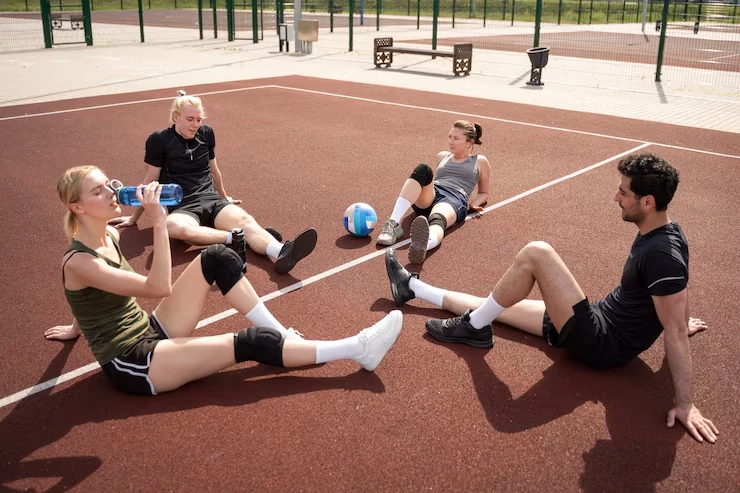Sports participation offers numerous health benefits, but it also comes with the risk of injury. Understanding which sports have the highest injury rates can help athletes, parents, coaches, and medical professionals make informed decisions about participation and safety measures. At Revolver News This article examines comprehensive data on sports with the most injuries, common injury types, and effective prevention strategies.
Sports With the Highest Injury Rates

When analyzing which sports produce the most injuries, it’s important to consider multiple factors including participation rates, injury severity, and reporting methods. Let’s examine the data behind the most injury-prone sports.
Football: Leading the Injury Statistics
American football consistently ranks among sports with the most injuries, particularly at high school and collegiate levels. According to the National Safety Council, football accounts for approximately 341,000 emergency room visits annually.
The National Collegiate Athletic Association (NCAA) reports that football has an injury rate of 8.1 injuries per 1,000 athlete exposures (an exposure is defined as one athlete participating in one practice or game). This is significantly higher than most other collegiate sports.
Key injury statistics for football:
- Concussions occur at a rate of 0.6 per 1,000 athlete exposures
- Knee injuries, including ACL tears, account for 17% of all football injuries
- Lower extremity injuries make up 50.4% of all football injuries
- Ankle sprains are the single most common injury
Dr. Robert Cantu, Medical Director of the National Center for Catastrophic Sport Injury Research, states: “Football combines high-speed movement with full-body contact, creating multiple injury risk factors that aren’t present in most other sports.”
Basketball: High Participation, High Injury Numbers

Basketball ranks second for total sports injuries in many studies, partly due to its high participation rates across age groups. The CDC reports that basketball accounts for approximately 500,000 injuries treated in emergency departments annually.
The injury rate in basketball stands at approximately 4.3 injuries per 1,000 athlete exposures at the collegiate level. Women’s basketball shows slightly higher injury rates than men’s in some studies.
Common basketball injuries include:
- Ankle sprains (26% of all basketball injuries)
- Knee injuries, including ACL tears
- Finger injuries
- Face and dental injuries
Soccer: Lower Extremity Vulnerability
Soccer presents significant injury risks, particularly to the lower body. Research published in the American Journal of Sports Medicine indicates that soccer has an injury rate of 4.6 to 7.7 injuries per 1,000 hours of participation.
Youth soccer players experience approximately 2-7 injuries per 1,000 hours of playing time, while professional players may experience 5-35 injuries per 1,000 hours of play.
Notable soccer injury statistics:
- Ankle injuries account for 20-30% of all soccer injuries
- Head injuries represent 4-22% of soccer injuries
- ACL tears occur 2-8 times more frequently in female soccer players than males
Ice Hockey: High-Impact Collisions
Ice hockey combines high speeds, hard playing surfaces, sharp equipment, and frequent collisions, creating multiple injury risks. The injury rate in ice hockey ranges from 4.1 to 8.2 per 1,000 athlete exposures.
According to the American Academy of Pediatrics, ice hockey accounts for approximately 67,000 emergency room visits annually. Youth hockey players experience 1-3 injuries per 1,000 player-hours, while professional players may experience 10-15 injuries per 1,000 player-hours.
Common hockey injuries include:
- Concussions (18-29% of all hockey injuries)
- Shoulder injuries
- Knee injuries
- Facial injuries
Wrestling: High Injury Rates Per Participant
Wrestling often goes unnoticed in injury discussions, but data from the NCAA shows that wrestling has one of the highest injury rates among collegiate sports at 9.6 injuries per 1,000 athlete exposures.
The National High School Sports-Related Injury Surveillance Study found that wrestling accounts for more injuries than many sports with higher participation rates.
Key wrestling injury statistics:
- Skin infections account for 8.5% of all wrestling injuries
- Knee injuries represent 24% of wrestling injuries
- Shoulder injuries account for 18% of wrestling injuries
What Is the #1 Injury Occurring in Sports?

Across most sports, certain injury types appear consistently in the data. Understanding these common injuries can help with prevention and treatment strategies.
Sprains and Strains: The Most Common Sports Injuries
Sprains (ligament injuries) and strains (muscle/tendon injuries) are the most frequently occurring sports injuries across virtually all activities. The American Academy of Orthopedic Surgeons reports that sprains and strains account for approximately 40% of all sports injuries treated in emergency departments.
Ankle sprains specifically are the single most common sports injury, with an estimated 2 million ankle sprains occurring annually in the United States. Basketball, soccer, and volleyball show particularly high rates of ankle sprains.
Concussions: A Growing Concern
While not the most frequent injury by raw numbers, concussions represent one of the most serious common sports injuries. The CDC estimates that between 1.6 and 3.8 million sports-related concussions occur annually in the United States.
Football has the highest concussion rates among team sports, with 0.6-0.8 concussions per 1,000 athlete exposures at the high school level. However, women’s soccer, ice hockey, and lacrosse also show concerning concussion rates.
Dr. Jeffrey Kutcher, Director of the Sports Neurology Clinic, notes: “The reporting of concussions has improved dramatically, but we still believe many go undiagnosed, particularly in sports without strong medical coverage.”
ACL Tears: Season-Ending and Career-Threatening
Anterior cruciate ligament (ACL) tears represent one of the most devastating common sports injuries. Approximately 200,000 ACL injuries occur annually in the United States, with 70% occurring during sports activities.
Sports with the highest ACL injury rates include:
- Women’s basketball (0.23 per 1,000 athlete exposures)
- Women’s soccer (0.28 per 1,000 athlete exposures)
- Men’s football (0.18 per 1,000 athlete exposures)
Female athletes face a 2-8 times higher risk of ACL tears than male athletes in similar sports, due to anatomical, hormonal, and neuromuscular factors.
Injury Rates by Sport Category

Different categories of sports present different injury risks based on their fundamental characteristics. Understanding these patterns can help athletes and healthcare providers anticipate and address specific concerns.
Contact Sports Injuries
Contact sports consistently show higher injury rates than non-contact activities. Full-contact sports like football, rugby, and ice hockey have injury rates ranging from 8-15 injuries per 1,000 athlete exposures.
Research published in the British Journal of Sports Medicine found that direct player contact accounts for 58% of injuries in rugby, 56% in ice hockey, and 46% in football.
Common contact sport injuries include:
- Concussions
- Shoulder dislocations
- Knee ligament tears
- Fractures
- Contusions
Individual vs. Team Sports
Individual sports often show lower overall injury rates than team sports, but the pattern varies significantly by activity. High-risk individual sports like gymnastics and skateboarding can produce severe injuries despite lower participation numbers.
The National Electronic Injury Surveillance System data shows that:
- Gymnastics has an injury rate of 4.8 per 1,000 participants
- Skateboarding results in approximately 70,000 emergency room visits annually
- Swimming shows one of the lowest injury rates at 0.5 per 1,000 participants
Youth Sports Injuries
Youth athletes present unique injury concerns due to their developing bodies and varying skill levels. According to the CDC, more than 2.6 million children and teenagers are treated in emergency departments for sports injuries each year.
The National SAFE KIDS Campaign reports that:
- Basketball accounts for 170,000 youth injuries annually
- Football accounts for 215,000 youth injuries annually
- Baseball and softball account for 110,000 youth injuries annually
Dr. Neeru Jayanthi of Emory University states: “Early sport specialization has contributed to rising rates of overuse injuries in youth athletes, particularly when training volume exceeds age-appropriate recommendations.”
Sports With the Most Hospital Visits

Emergency department data provides another lens for examining sports injury rates. This data captures more severe injuries requiring immediate medical attention.
Emergency Room Visits by Sport
According to the National Safety Council and Consumer Product Safety Commission data, these sports account for the most emergency room visits annually:
- Basketball: 500,000
- Football: 341,000
- Soccer: 215,000
- Baseball/Softball: 172,000
- Cycling: 457,000
- Exercise equipment: 409,000
- All-terrain vehicles: 93,000
- Ice/roller skating: 58,000
Dr. Gary Green, Medical Director for Major League Baseball, notes: “Emergency room data captures acute traumatic injuries well, but may underrepresent chronic and overuse injuries that account for significant time loss in many sports.”
Sports Injury Hospitalization Rates
Beyond emergency room visits, hospitalization rates indicate the most severe injuries requiring extended care. Research published in the Journal of Athletic Training found that:
- Football accounts for 14.1% of all sports-related hospitalizations
- Off-road vehicle use accounts for 11.7%
- Basketball accounts for 8.9%
- Soccer accounts for 6.2%
Traumatic brain injuries and complex fractures represent the most common reasons for sports-related hospitalizations across all activities.
Most Dangerous Sports by Injury Severity

While frequency data is important, injury severity also matters when assessing sports risks. Some activities produce fewer total injuries but have higher rates of severe or catastrophic outcomes.
Catastrophic Injury Rates
Data from the National Center for Catastrophic Sport Injury Research identifies these activities as having the highest rates of catastrophic injuries:
- Cheerleading: 66% of all catastrophic injuries among female athletes
- Football: 0.6 catastrophic injuries per 100,000 participants
- Ice hockey: 0.3 catastrophic injuries per 100,000 participants
- Gymnastics: 0.3 catastrophic injuries per 100,000 participants
Catastrophic injuries include severe spinal cord injuries, traumatic brain injuries resulting in permanent disability, and fatalities.
Sports With Highest Fatality Rates
While extremely rare, fatal sports injuries do occur. Research published in the journal Pediatrics examined fatality rates across youth sports:
- Base jumping: 1 death per 2,300 jumps
- Hang gliding: 1 death per 116,000 flights
- Scuba diving: 1 death per 34,400 dives
- Mountain climbing: 1 death per 1,750 climbers
- Motorcycle racing: 1 death per 1,000 participants
Among traditional team sports, football has the highest fatality rate at approximately 0.9 deaths per 100,000 participants annually.
Common Types of Sports Injuries
Understanding the most frequent injury types can help athletes recognize warning signs and seek appropriate care.
Acute vs. Chronic Injuries in Sports
Sports injuries generally fall into two categories:
Acute injuries occur suddenly during activity. Examples include:
- Sprains
- Strains
- Fractures
- Dislocations
- Contusions
Chronic injuries develop over time due to repetitive stress. Examples include:
- Tendinitis
- Stress fractures
- Bursitis
- Growth plate injuries in youth athletes
Research in the Journal of Athletic Training found that 29.3% of all sports injuries are overuse injuries, with higher rates in endurance sports and activities involving repetitive motions.
Traumatic Brain Injuries in Sports
Concussions and other traumatic brain injuries represent a growing concern across many sports. The American Association of Neurological Surgeons reports that:
- 10-15% of all football players experience a concussion in a given season
- 5-10% of athletes in contact sports sustain concussions annually
- 19% of high school athletes playing a contact sport report a concussion in their athletic career
Dr. Robert Cantu states: “We’ve seen dramatic improvements in concussion awareness and management, but more progress is needed, particularly in youth sports where medical coverage may be limited.”
Orthopedic Sports Injuries
Injuries to bones, joints, and surrounding tissues account for the majority of sports injuries. The American Academy of Orthopedic Surgeons reports these as the most common orthopedic sports injuries:
- Ankle sprains
- Knee injuries (including ACL, MCL, and meniscus tears)
- Shoulder injuries (including dislocations and rotator cuff injuries)
- Tennis/golfer’s elbow
- Hamstring strains
- Fractures
Dr. James Andrews, renowned orthopedic surgeon, notes: “Many orthopedic sports injuries are preventable through proper conditioning, technique training, and appropriate rest periods.”
Risk Factors for Sports Injuries

Multiple factors influence injury risk beyond simply which sport an athlete plays. Understanding these risk factors can help identify vulnerable athletes and develop targeted prevention strategies.
Physical Contact and Collision Risk
Direct physical contact represents the leading cause of acute injuries in many sports. Research in the American Journal of Sports Medicine found that:
- 58% of football injuries involve player-to-player contact
- 42% of basketball injuries involve player contact
- 46% of soccer injuries involve player contact
Sports with intentional collisions as part of gameplay (football, rugby, ice hockey) consistently show higher injury rates than non-contact sports.
Training Errors and Overtraining
Improper training methods contribute significantly to injury risk across all sports. A study in the British Journal of Sports Medicine identified these training-related risk factors:
- Rapid increases in training volume (>10% per week)
- Inadequate recovery between intense training sessions
- Year-round training without appropriate off-seasons
- Poor technique during strength training
Dr. Lyle Micheli of Boston Children’s Hospital notes: “Many young athletes train too much, too hard, too soon, and with too little recovery time, creating perfect conditions for overuse injuries.”
Equipment and Playing Surface
Equipment issues and playing surface conditions contribute to injury risk in many sports. Research has found that:
- Football players wearing properly fitted helmets have a 31% lower risk of concussion
- Soccer players on artificial turf experience 15-50% more injuries than those playing on natural grass
- Basketball players wearing ankle braces have a 69% lower risk of ankle injury
Injury Prevention in Sports

While injury risk exists in all physical activities, evidence-based prevention strategies can significantly reduce both the frequency and severity of sports injuries.
Protective Gear and Its Effectiveness
Proper protective equipment represents a critical injury prevention strategy in many sports. Research on protective gear effectiveness shows:
- Football helmets reduce concussion risk by 20-30% when properly fitted
- Mouthguards reduce dental injury risk by 60% in contact sports
- Ankle braces reduce ankle sprain risk by 50-70% in basketball and volleyball
Dr. Kevin Guskiewicz, concussion researcher, cautions: “While protective equipment is important, no helmet can completely prevent concussions, and the perception of protection can sometimes lead to riskier behavior.”
Proper Training and Conditioning
Appropriate physical preparation significantly reduces injury risk across all sports. Evidence-based training approaches include:
- Neuromuscular training programs reduce ACL injury risk by 50-80%
- Gradual progression of training volume (no more than 10% increase per week)
- Sport-specific strength training targeting vulnerable muscle groups
- Balance training reduces ankle sprain risk by 36%
Rule Changes and Safety Measures
Sport governing bodies have implemented numerous rule changes aimed at reducing injury risk:
- Football tackling rule changes have reduced concussion rates at the high school level by 4.2%
- Soccer heading restrictions for youth players have reduced concussion rates by 30%
- Baseball pitch count limits have reduced shoulder and elbow injuries by 50% in youth baseball
Dr. Dawn Comstock, injury epidemiologist, states: “Rule changes represent one of our most effective tools for reducing injury risk while preserving the fundamental nature of a sport.”
Sports Injury Statistics Across Age Groups

Injury patterns vary significantly across different age groups due to developmental, physiological, and participation differences.
Youth Sports Injuries
Youth athletes (5-14 years) face unique injury risks due to their developing bodies. According to Safe Kids Worldwide:
- 62% of organized sports injuries occur during practice rather than games
- Nearly 50% of youth sports injuries are overuse injuries
- Children ages 5-14 account for nearly 40% of all sports-related injuries treated in hospitals
Growth plate injuries represent a particular concern in youth athletes, accounting for 15-30% of all skeletal injuries in children.
High School Sports Injuries
High school athletes experience approximately 1.4 million injuries annually, according to the National Federation of State High School Associations. Key statistics include:
- Football accounts for 28% of all high school sports injuries
- Girls’ soccer shows the highest concussion rate among female high school sports
- 30% of high school athletes competing with an injury report re-injury
College and Professional Sports Injuries
Elite athletes face high injury risks due to intense competition and training demands:
- NCAA athletes sustain approximately 210,000 injuries annually
- NFL players experience an average of 2,000 injuries per season across the league
- NBA players miss an average of 4.8 games per season due to injury
Medical Care for Sports Injuries

Proper medical care plays a crucial role in managing sports injuries and preventing long-term complications.
Immediate Treatment Approaches
The RICE protocol (Rest, Ice, Compression, Elevation) remains the standard first-aid approach for many acute sports injuries. Research published in the Journal of Athletic Training supports this approach for reducing pain and swelling in the acute phase of injury.
For concussions, immediate removal from play and appropriate medical evaluation has been shown to reduce recovery time by 50% compared to athletes who continue playing.
Rehabilitation and Return to Play
Comprehensive rehabilitation improves outcomes and reduces re-injury risk:
- ACL reconstruction followed by structured rehabilitation allows 82% of athletes to return to sport
- Ankle sprain rehabilitation reduces re-injury risk by 45%
- Concussion rehabilitation protocols reduce persistent symptoms by 35%
Dr. Brian Hainline, Chief Medical Officer of the NCAA, emphasizes: “Return to play decisions should be individualized based on the specific injury, sport demands, and the athlete’s full recovery status, not just the absence of symptoms.”
Frequently Asked Questions
How frequently do sports injuries occur?
Sports injuries occur at a rate of approximately 2-3 million per year among young athletes alone in the United States. Overall, the CDC estimates that 8.6 million sports and recreation-related injuries occur annually among Americans of all ages. The frequency varies significantly by sport, with contact sports showing higher rates than non-contact activities.
What factors make certain sports more dangerous than others?
Several factors contribute to injury risk in sports:
- Speed and momentum (higher speeds create greater injury potential)
- Direct physical contact between participants
- Playing surface hardness
- Equipment used (both protective and potentially dangerous)
- Required movements (pivoting, jumping, repetitive motions)
- Environmental factors (heat, altitude, etc.)
Do male and female athletes experience different injury rates?
Yes, research consistently shows gender differences in injury patterns. Female athletes experience 2-8 times more ACL tears than males in similar sports, particularly in basketball and soccer. Male athletes typically experience higher rates of contact injuries in sports like football and wrestling. These differences stem from anatomical, hormonal, and neuromuscular factors, as well as differences in playing style.
What are the most effective ways to prevent sports injuries?
Evidence-based prevention strategies include:
- Proper conditioning and sport-specific training
- Neuromuscular training programs (particularly for ACL injury prevention)
- Appropriate protective equipment
- Adherence to safety rules
- Proper technique instruction
- Adequate recovery time between training sessions and competitions
- Gradual progression of training intensity and volume
How do childhood sports injuries differ from adult injuries?
Children and adolescents face unique injury concerns, including:
- Growth plate injuries that can affect bone development
- Higher risk of certain fractures due to developing bone structure
- Different concussion recovery patterns
- Overuse injuries related to developing musculoskeletal systems
- Greater risk from improper technique due to developing coordination
Children also typically have longer recovery times for certain injuries, including concussions, compared to adults.
What sports have the lowest injury rates?
According to the National Safety Council and various research studies, these sports tend to have lower injury rates:
- Swimming (0.5 injuries per 1,000 exposures)
- Table tennis (1.0 injuries per 1,000 exposures)
- Golf (1.2 injuries per 1,000 exposures)
- Volleyball (1.7 injuries per 1,000 exposures)
- Baseball (1.8 injuries per 1,000 exposures)
Non-contact individual sports generally show lower acute injury rates, though overuse injuries still occur in activities like swimming and golf.
How have injury rates changed over time in popular sports?
Injury tracking data shows mixed trends:
- Football concussion rates decreased by 4.2% at the high school level following tackling rule changes
- ACL injuries have increased by 2.3% annually over the past decade
- Youth sport specialization has contributed to a 30% increase in overuse injuries
- Improved reporting and awareness have likely increased identification of certain injuries, particularly concussions
What is the economic impact of sports injuries?
The economic burden of sports injuries is substantial:
- Annual medical costs for sports injuries exceed $33 billion in the United States
- The average cost of an ACL reconstruction is $20,000-$50,000
- High school athletes lose approximately 500,000 days of school annually due to sports injuries
- Long-term costs of serious injuries, including early osteoarthritis following joint injuries, add billions in healthcare costs
Expert Professional Statistics
According to Dr. James Andrews, renowned orthopedic surgeon who has worked with professional athletes across multiple sports: “We see approximately 3.5 million sports injuries annually among youth athletes alone. About 50% of these are preventable through proper training, equipment, and coaching.
The American Orthopedic Society for Sports Medicine reports that “over 90% of sports injuries do not require surgery, but proper initial care and rehabilitation are essential for optimal recovery.
Dr. Neeru Jayanthi, sports medicine physician at Emory University, found in his research that “young athletes who specialize in a single sport are 70-93% more likely to be injured than those who play multiple sports.
The National Athletic Trainers‘ Association states that “schools with athletic trainers report 22% lower injury rates among student athletes compared to schools without access to these professionals.
According to research from the American Academy of Pediatrics, “approximately 40% of all sports-related injuries treated in emergency departments are sustained by children ages 5-14.

